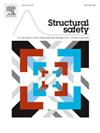Probabilistic life-cycle assessment of landslides exposed to both rainfall under nonstationary climate change effects and earthquakes
IF 6.3
1区 工程技术
Q1 ENGINEERING, CIVIL
引用次数: 0
Abstract
Combined effects of rainfall and seismic hazards pose significant threats to structures and infrastructure systems. Additionally, climate change is projected to impact the intensity and frequency of future rainfall, increasing the likelihood of landslides. However, evaluating long-term landslide probability under the combined effects of rainfall and seismic hazards, while considering nonstationary climate change, presents significant challenges due to the distinct characteristics of their occurrence processes. This study introduces a novel framework for probabilistic life-cycle landslide assessment that systematically integrates climate change effects on rainfall hazard along with seismic hazard. Probabilistic nonstationary rainfall and seismic hazard models are developed by leveraging stochastic renewal process theory based on occurrence probability and the associated hazard intensity distribution. Slope fragility assessments are conducted for four event scenarios: individual rainfall, individual earthquake, rainfall followed by an earthquake, and an earthquake followed by rainfall, using seepage and equivalent linear analysis through Monte Carlo simulation. Finally, using the total probability theorem, life-cycle landslide probability is numerically evaluated by convolving nonstationary rainfall and seismic hazards with slope fragilities. An illustrative example is provided by applying the proposed framework to a slope in Hiroshima city, Japan, to explore how the combined effects between nonstationary rainfall and seismic hazards impact life-cycle landslide probability.
非平稳气候变化和地震下降雨作用下滑坡的概率生命周期评估
降雨和地震灾害的综合影响对建筑物和基础设施系统构成了重大威胁。此外,预计气候变化将影响未来降雨的强度和频率,增加发生山体滑坡的可能性。然而,在考虑非平稳气候变化的情况下,评估降雨和地震灾害联合作用下的长期滑坡概率,由于其发生过程的不同特征,提出了重大挑战。本文提出了一个新的滑坡概率生命周期评估框架,该框架系统地综合了气候变化对降雨灾害和地震灾害的影响。利用随机更新过程理论,建立了基于发生概率和相关灾害强度分布的概率非平稳降雨和地震灾害模型。采用渗流分析和蒙特卡罗模拟等效线性分析,对单次降雨、单次地震、先降雨后地震、先地震后降雨四种事件情景进行边坡脆弱性评价。最后,利用全概率定理,将非平稳降雨、地震灾害与边坡脆弱性进行卷积,对边坡生命周期滑坡概率进行数值计算。以日本广岛某边坡为例,探讨了非平稳降雨和地震灾害对边坡生命周期滑坡概率的综合影响。
本文章由计算机程序翻译,如有差异,请以英文原文为准。
求助全文
约1分钟内获得全文
求助全文
来源期刊

Structural Safety
工程技术-工程:土木
CiteScore
11.30
自引率
8.60%
发文量
67
审稿时长
53 days
期刊介绍:
Structural Safety is an international journal devoted to integrated risk assessment for a wide range of constructed facilities such as buildings, bridges, earth structures, offshore facilities, dams, lifelines and nuclear structural systems. Its purpose is to foster communication about risk and reliability among technical disciplines involved in design and construction, and to enhance the use of risk management in the constructed environment
 求助内容:
求助内容: 应助结果提醒方式:
应助结果提醒方式:


